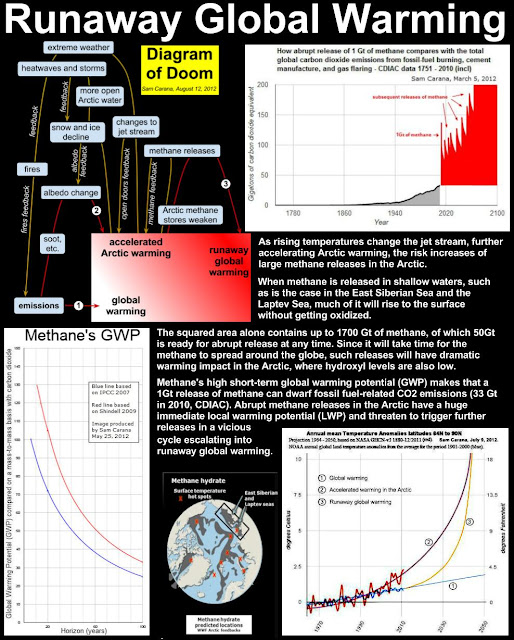Arctic sea ice area reached a record low of 2.87746 million square km on the 230th day of 2012, as illustrated on the image below by The Cryosphere Today. Below the sea surface temperature anomaly for August 20, 2012, by the National Oceanic and Atmospheric Administration (NOAA). The poster forms part of the updated presentation Why act now, and how? |
Monday, August 20, 2012
Record low sea ice area
Sunday, August 19, 2012
Tipping Points
The increasing melt may be a harbinger of greater changes such as the release of methane compounds from frozen soils that could exacerbate warming, and a thaw of the Greenland ice sheet, which would contribute to rising sea levels, NASA’s top climate scientist, James Hansen, said in an e-mail interview, reports Bloomberg.
“Our greatest concern is that loss of Arctic sea ice creates a grave threat of passing two other tipping points -- the potential instability of the Greenland ice sheet and methane hydrates,” Hansen said. “These latter two tipping points would have consequences that are practically irreversible on time scales of relevance to humanity.”
Above image shows methane levels over a period of four years, from August 1, 2008, to August 1, 2012.
Above image shows methane levels over one years, from August 1, 2011, to August 1, 2012. This shows a marked increase in methane levels on the last of the four years further above.
Above image shows methane levels from August 1, 2012, to August 15, 2012. The image shows high levels of methane across the northern hemisphere. Note the high levels above Greenland.
“Our greatest concern is that loss of Arctic sea ice creates a grave threat of passing two other tipping points -- the potential instability of the Greenland ice sheet and methane hydrates,” Hansen said. “These latter two tipping points would have consequences that are practically irreversible on time scales of relevance to humanity.”
Above image shows methane levels over a period of four years, from August 1, 2008, to August 1, 2012.
Above image shows methane levels over one years, from August 1, 2011, to August 1, 2012. This shows a marked increase in methane levels on the last of the four years further above.
Above image shows methane levels from August 1, 2012, to August 15, 2012. The image shows high levels of methane across the northern hemisphere. Note the high levels above Greenland.
Friday, August 17, 2012
Arctic sea ice updates
Above diagram shows sea ice extent as calculated by the Polar View team at the University of Bremen, Germany.
Paul Beckwith warns that a second cyclone is threatening to batter the remaining sea ice soon.
View Paul's presentation by clicking on the link below.
https://docs.google.com/file/d/0ByLujhsHsxP7cnB0bXhNNFFSQjQ/edit
Or, view the presentation in the window below (it may take some time for the file to fully load).
Opening the Doorways to Doom
Snow and ice protect the Arctic from overheating in summer. Firstly the brightness of the snow and ice cover ensures that most sunlight gets reflected back into space. Secondly, a lot of the sunlight that isn't reflected will be consumed by the process of turning snow and ice into water, which occurs while temperatures remain at the melting point of 0°C (32°F, 273.15 K).
The Arctic is further protected from overheating by the polar jet stream, which keeps cold air in the Arctic and keeps warm air out.
Accelerated warming in the Arctic can alter the polar jet stream in a number of ways, firstly by slowing its speed and secondly by increasing its waviness. Larger swings in the jet stream allow frigid air from the Arctic to plunge farther south, as well as warm, moist tropical air to penetrate northward, explains Jennifer Francis, research professor at the Institute of Marine and Coastal Sciences at Rutgers University.
Accelerated warming in the Arctic comes with many feedbacks, and this "open doors feedback" is only one of them. Higher temperatures and more open water in the Arctic can also be expected to increase the danger that storms will batter the sea ice with greater ferocity.
In many ways, it's opening the doorways to doom. The biggest danger is that Arctic methane stores will weaken, causing huge amounts of methane to be released, triggering warming that could escalate into runaway global warming.
The Arctic is further protected from overheating by the polar jet stream, which keeps cold air in the Arctic and keeps warm air out.
 |
| The polar jet stream can travel at speeds greater than 100 mph. Here, the fastest winds are colored red; slower winds are blue. View animated version here. Credit: NASA/Goddard Space Flight Center |
Accelerated warming in the Arctic can alter the polar jet stream in a number of ways, firstly by slowing its speed and secondly by increasing its waviness. Larger swings in the jet stream allow frigid air from the Arctic to plunge farther south, as well as warm, moist tropical air to penetrate northward, explains Jennifer Francis, research professor at the Institute of Marine and Coastal Sciences at Rutgers University.
Accelerated warming in the Arctic comes with many feedbacks, and this "open doors feedback" is only one of them. Higher temperatures and more open water in the Arctic can also be expected to increase the danger that storms will batter the sea ice with greater ferocity.
In many ways, it's opening the doorways to doom. The biggest danger is that Arctic methane stores will weaken, causing huge amounts of methane to be released, triggering warming that could escalate into runaway global warming.







